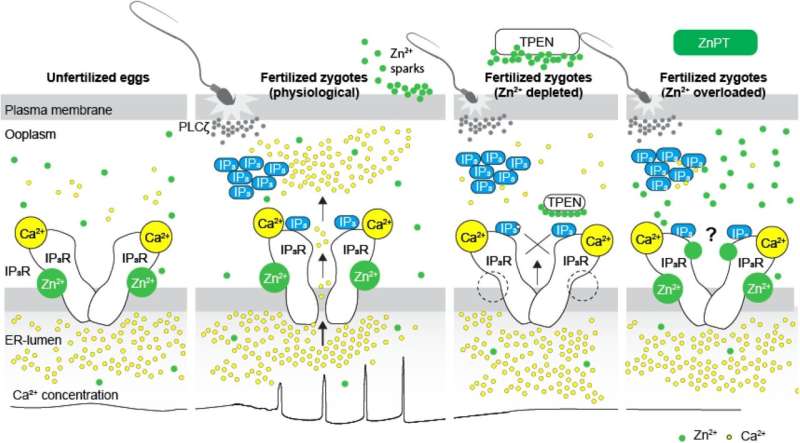This article has been reviewed according to Science X's editorial process and policies. Editors have highlighted the following attributes while ensuring the content's credibility:
fact-checked
peer-reviewed publication
trusted source
proofread
Zinc and calcium ions 'crosstalk' to allow proper egg fertilization, study finds

Researchers have detailed the effects of zinc ion deficiency and excess on the periodical release of calcium ions, known as calcium oscillations—a process crucial for proper egg activation during fertilization, and the ultimate success of the resulting embryo.
The study in mice, published today as an eLife Reviewed Preprint, provides what the editors describe as compelling evidence that zinc ions regulate calcium oscillations by directly modulating the calcium channel IP3R1.
The findings could be used to inform the development of improved methods of IVF treatments for women undergoing assisted reproduction, or non-hormonal contraceptive measures.
In mammals, calcium oscillations are a hallmark signal of egg activation and fertilization. They consist of periodical calcium ion increases that promote the progression to the next stage of embryo development. The production of the signaling molecule IP3, which then binds to its associated receptor, IP3R1, on the egg cell, causes the release of calcium ions from the egg's main calcium reservoir.
During oocyte (the term for an immature egg cell) maturation prior to fertilization, the levels of zinc ions in the egg cell dramatically increase, which is also crucial for the next steps of embryo development. Following fertilization and the initiation of calcium oscillations, approximately 10%–20% of the zinc ions are ejected in an event known as "zinc sparks"—a process that occurs in both vertebrate and invertebrate species.
"Fertilization relies on calcium oscillations, and zinc sparks are an egg activation event that occurs downstream of calcium release. This establishes a functional association between the two ions that continues to grow," explains co-lead author Emily Lopes, a Ph.D. candidate in the Department of Veterinary and Animal Sciences, and the Molecular and Cellular Biology Graduate Program, University of Massachusetts Amherst.
"Previous studies have demonstrated the importance of zinc ions for the successful completion of fertilization," says co-lead author Hiroki Akizawa, a Postdoctoral Researcher in the Department of Veterinary and Animal Sciences, University of Massachusetts Amherst. "However, whether there is any crosstalk between the ions, or if zinc levels impact calcium release during fertilization is unknown."
To explore this further, the team used various methods to raise and lower zinc levels in mouse eggs, while stimulating calcium oscillations following routine procedures. They then monitored the resulting calcium oscillations during egg activation using a variety of well-established methods of calcium measurements.
The team discovered that, when zinc was made unavailable by bonding it with a compound called TPEN, calcium oscillations ceased, without reducing the store of calcium ions in the egg's reservoir, production of IP3, or the viability of the egg itself. This occurred regardless of the compound used to stimulate egg activation, including fertilization. The results suggest that zinc deficiency impaired the function of the IP3R1 receptor, the only shared molecule by all the activating stimuli, lessening its ability to facilitate calcium ion release.
The team found that restoring zinc levels re-established the calcium oscillations. However, increasing zinc levels too much once again disrupted the calcium oscillations and prevented egg activation. Taken together, these results suggest that zinc has a central role in the regulation of calcium levels during fertilization, and that an optimal amount of zinc is required for calcium oscillations to occur.
The team further consolidated this finding by investigating how zinc affects the IP3R1 receptor. They used a compound called thapsigargin to inhibit the SERCA pump of the receptor—which facilitates the release of calcium ions. This caused calcium to leak from the IP3R1 receptor. However, when the team added TPEN, the calcium leak slowed, resulting in delayed and decreased calcium release. This also suggests that zinc is necessary for calcium oscillations to occur due to its role in the function of IP3R1 receptors.
"Our study reveals that calcium and zinc ions actively crosstalk during fertilization, and that fertilization-induced calcium oscillations rely on the optimized function of IP3R1 receptors brought about in part by ideal levels of zinc ions," concludes senior author Rafael Fissore, a Professor in the Department of Veterinary and Animal Sciences, University of Massachusetts Amherst. "This paves the way for future studies to explore if artificial alteration of zinc levels can extend the fertile lifespan of eggs, improve the reliability of egg development, or act as a non-hormonal method of contraception."
More information: Hiroki Akizawa et al, Zn2+ is Essential for Ca2+ Oscillations in Mouse Eggs, eLife (2023). DOI: 10.7554/eLife.88082.1
Journal information: eLife
Provided by eLife



















